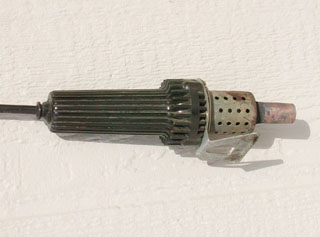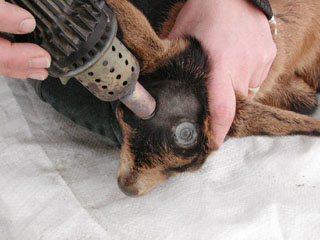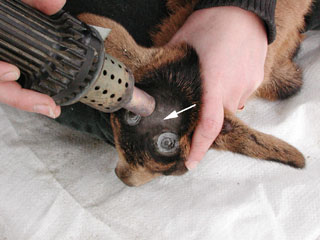
| This is a common electric disbudding and descenting device. |
BUY THIS MANUAL NOW and have access to this article and 100's of others just like it!
View some of the 10+ Video clips found in the Small Ruminant Manual
Introduction:
Many meat, pet, and fiber goat owners prefer to leave the horns on their goats. Many of the dairy goat owners, however, prefer to have the horns removed for safety reasons. If the decision is made to remove the horns, ALL goats should be disbudded in infancy. Male goats can be descented at the same time. The ideal time to perform these procedures is when the kid is 5-7 days old. There are different techniques that have been used, but only burning with a hot iron is safe and routinely successful. Dehorning adult animals requires anesthetic and usually surgical procedures performed by a veterinarian.Procedure: An electric disbudding iron with a tip that is 3/4 to 1 inch in diameter can be used. A section of hollow metal pipe of the appropriate diameter (3/4 to 1 inch) or a branding iron with a large steel nut welded to it can also be used. All of these instruments should be heated until they are cherry red. The hair over each horn bud and scent gland should be clipped and one of the burning devices applied to the area (see the following pictures for exact locations). The iron should be left in contact with the skin until the full thickness of the skin has been destroyed. Once the full thickness of the skin has been destroyed, it turns to a black/copper color that cannot be scraped off by a fingernail. In cases where the iron has a sharp end, it can be used to actually push through the full skin layer and remove the central circle of skin completely. The kid will often return to normal activity once the hot iron has been removed.
Tetanus Prevention: All adult goats should be vaccinated with a tetanus toxoid prior to performing a dehorning procedure. A booster of this vaccine should be given at the time of dehorning. Tetanus toxoid vaccines should also be considered in kids when they are disbudded at older ages. If the vaccination status of the animal is not known, then tetanus antitoxin should be administered at the time of disbudding/dehorning (250 IU should be given to kids and 500 IU should be given to adults). If a kid received adequate colostrum from a doe that had been vaccinated previously for tetanus, the kid will naturally have some immunity to tetanus. If there is any question about the quality or quantity of the colostrum the kid received, administer the antitoxin.
Alternative Methods for Disbudding and Dehorning Include (not recommended):
 |
|
 |
|
 |
|
BUY THIS MANUAL NOW and have access to this article and 100's of others just like it!
View some of the 10+ Video clips found in the Small Ruminant Manual